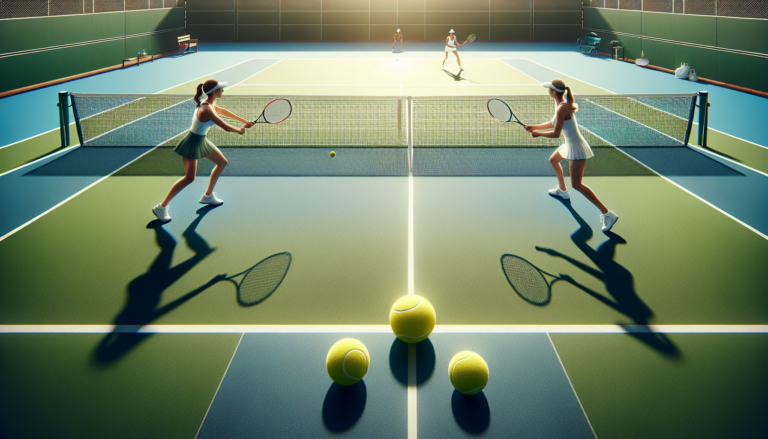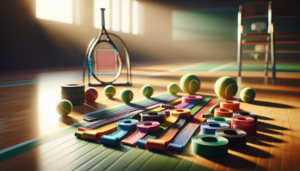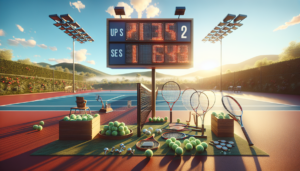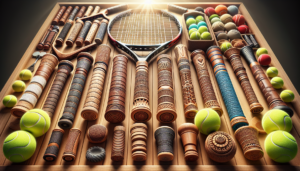Tennis doubles is an exciting and dynamic format of the sport that requires teamwork, communication, and strategic gameplay. In this comprehensive guide, we’ll explore the rules, strategies, and essential aspects of doubles tennis to help you understand and excel in this thrilling variation of the game.
Whether you’re a seasoned singles player looking to expand your skills or a beginner eager to dive into the world of doubles, this article will provide you with the knowledge and insights needed to navigate the court with confidence.
Introduction to Tennis Doubles Rules
What is Doubles Tennis?
Doubles tennis is a format of the sport where teams of two players compete against each other. Unlike singles, where individual skills and strategies are paramount, doubles tennis emphasizes teamwork and communication between partners. The objective remains the same: to hit the ball over the net and into the opponent’s court, preventing them from returning it successfully.
Doubles tennis can be played in both men’s, women’s, and mixed categories, with slight variations in court dimensions and serving positions. The fast-paced nature of the game, combined with the need for coordination and understanding between teammates, makes doubles tennis an exhilarating and challenging experience.
Basic Rules of Doubles Tennis
The basic rules of doubles tennis are similar to those of singles, with a few key differences. The court dimensions for doubles are slightly wider than for singles, allowing for more lateral movement and coverage. The serving rotation also differs, with each team having two opportunities to serve before the serve switches to the opposing team.
In doubles, the server must serve diagonally across the court, starting from the right side of the baseline and alternating sides after each point. The receiving team can choose which player will receive the serve, and the partner of the receiver stands at the service line on their respective side. Understanding the basic rules of doubles tennis is essential for effective gameplay and strategy.
Gameplay Strategies in Doubles Tennis
Effective Teamwork and Communication
One of the most crucial aspects of successful doubles tennis is effective teamwork and communication between partners. Unlike singles, where players must rely solely on their own skills and decision-making, doubles requires a high level of coordination and understanding between teammates.
Effective communication involves calling out shots, discussing strategies during changeovers, and providing encouragement and support throughout the match. Partners should establish a clear system of verbal and non-verbal cues to ensure they are on the same page and can anticipate each other’s movements and intentions.
Court Positioning and Net Play
Proper court positioning is vital in doubles tennis, as it allows teams to cover more ground and create offensive opportunities. Generally, one player takes the “net” position, while the other covers the baseline. The net player is responsible for intercepting volleys and putting away short balls, while the baseline player handles deeper shots and lobs.
Effective net play involves quick reflexes, precise volleys, and the ability to anticipate the opponent’s shots. Communicating with your partner to coordinate positioning and shot selection is key to successful net play. By working together and covering the court efficiently, doubles teams can put pressure on their opponents and create winning opportunities.
Serving and Returning in Doubles Tennis
Effective Serving Techniques
Serving in doubles tennis requires a slightly different approach than in singles. With the wider court dimensions and the presence of the net player, serves must be strategically placed to maximize their effectiveness. Serving down the middle of the court can be a effective tactic, as it forces the receiving team to communicate and decide who will take the shot.
Varying the speed, spin, and placement of serves can also keep opponents guessing and create opportunities for the serving team to take control of the point. Effective serving techniques in doubles include slice serves, kick serves, and flat serves, each with their own advantages depending on the situation.
Strategies for Returning Serves
Returning serves in doubles tennis requires quick reflexes, good positioning, and communication with your partner. The receiving team must decide who will take the return based on the placement and speed of the serve. Generally, the player on the same side as the serve will take the return, while their partner covers the middle of the court.
Effective return strategies involve attacking weak second serves, targeting the middle of the court to create confusion, and using angles to open up the court for the returning team. By putting pressure on the serving team and neutralizing their advantage, the returning team can gain control of the point and set themselves up for offensive opportunities.
Scoring and Match Formats in Doubles Tennis
Understanding the Scoring System
The scoring system in doubles tennis follows the same format as singles, with a few variations. Matches are typically played in a best-of-three-sets format, with each set being won by the first team to reach six games with a two-game lead. If the set is tied at 6-6, a tiebreaker is played to determine the winner.
In doubles, the serving rotation adds an extra layer of complexity to the scoring. Each team has two opportunities to serve before the serve switches to the opposing team. Understanding the scoring system and serving rotation is crucial for keeping track of the match and making strategic decisions.
Different Match Formats
Doubles tennis can be played in various match formats, depending on the tournament or league settings. Some common formats include:
- Best-of-three sets: The most common format, where the first team to win two sets is declared the winner.
- Pro sets: A single set played to eight or ten games, with a tiebreaker at 7-7 or 9-9.
- Match tiebreaks: Instead of a third set, a ten-point tiebreaker is played to determine the winner.
- No-ad scoring: In this format, the first team to win four points wins the game, with no “advantage” points played.
Familiarizing yourself with the different match formats will help you adapt your strategies and pacing accordingly.
Common Mistakes and Tactical Awareness
Avoiding Common Mistakes
Doubles tennis is a fast-paced and dynamic game, and it’s easy to fall into common traps and make mistakes. Some frequent errors include:
- Poor communication with your partner
- Overcrowding the middle of the court
- Failing to adjust to your partner’s strengths and weaknesses
- Not varying your serves and returns
- Neglecting court positioning and coverage
By being aware of these common pitfalls and actively working to avoid them, you can elevate your doubles game and increase your chances of success on the court.
Improving Tactical Awareness
Tactical awareness is a key component of successful doubles tennis. It involves anticipating your opponents’ moves, recognizing patterns in their play, and adapting your strategies accordingly. Improving your tactical awareness requires a combination of experience, observation, and communication with your partner.
Some tips for enhancing your tactical awareness include:
- Studying your opponents’ strengths and weaknesses during the warm-up
- Paying attention to your opponents’ court positioning and shot selection
- Discussing strategies with your partner during changeovers
- Being flexible and willing to adjust your gameplan as needed
By honing your tactical awareness, you’ll be better equipped to make split-second decisions and outmaneuver your opponents on the court.
Practice Drills for Doubles Tennis
Coordination and Reflex Drills
Doubles tennis requires quick reflexes and excellent coordination between partners. Incorporating specific drills into your practice routine can help develop these essential skills. Some effective coordination and reflex drills include:
- Volley-to-volley drills: Partners take turns hitting volleys to each other from the service line, focusing on quick reactions and precise placement.
- Lobster drills: One player hits lobs while the other practices overhead smashes, simulating a common doubles scenario.
- Reflex volleys: The coach or a partner feeds rapid-fire volleys to the player at the net, who must react quickly and return each shot.
Regularly incorporating these drills into your practice sessions will sharpen your reflexes and improve your ability to work seamlessly with your partner.
Teamwork and Communication Drills
Effective teamwork and communication are the cornerstones of successful doubles play. Drills that focus on these aspects help partners develop a strong on-court rapport and understanding. Some valuable teamwork and communication drills include:
- Crosscourt and down-the-line drills: Partners take turns hitting crosscourt and down-the-line shots, emphasizing communication and shot anticipation.
- Half-court drills: Partners practice divide-and-conquer strategies by responsibly covering half of the court each, improving court positioning and coverage.
- Serve and return drills: One partner serves while the other practices returns from different positions, focusing on communication and coordination.
By dedicating time to these drills, doubles teams can build trust, anticipation, and a shared understanding of their on-court roles and responsibilities.
Equipment Recommendations for Doubles Tennis
Choosing the Right Racquets and Balls
Having the right equipment can make a significant difference in your doubles game. When selecting a racquet, consider factors such as weight, balance, and string pattern. Generally, lighter racquets with open string patterns are well-suited for doubles, as they provide more maneuverability and spin potential.
As for balls, most doubles matches are played with standard pressurized balls, but some tournaments may use extra-duty balls for longer wear on hard courts. Experimenting with different ball types during practice can help you adapt to various playing conditions.
Footwear and Other Gear
Proper footwear is essential for maintaining traction, stability, and comfort on the court. Look for tennis shoes with good lateral support and cushioning to withstand the quick movements and frequent directional changes in doubles play.
Other gear to consider includes:
- Performance clothing: Breathable, moisture-wicking fabrics help keep you cool and dry during intense rallies.
- Overgrips and dampeners: These accessories can enhance your grip and reduce vibration, improving your overall comfort and control.
- Wristbands and headbands: Keeping sweat at bay is crucial for maintaining focus and avoiding distractions during matches.
Investing in high-quality, comfortable gear can help you perform at your best on the doubles court.
Fitness and Conditioning for Doubles Tennis
Fitness Routines for Tennis Players
Maintaining a high level of fitness is crucial for excelling in doubles tennis. A well-rounded fitness routine should include exercises that target endurance, strength, agility, and flexibility. Some key components of a tennis-specific fitness program include:
- Cardiovascular training: Running, cycling, or swimming to improve endurance and stamina.
- Strength training: Exercises that target the legs, core, and upper body to enhance power and stability on the court.
- Agility drills: Ladder drills, cone drills, and other exercises that improve footwork and quick directional changes.
- Flexibility and mobility work: Stretching and yoga to maintain range of motion and prevent injuries.
Incorporating a balanced fitness routine into your training will help you stay sharp, energized, and injury-free on the doubles court.
Conditioning Exercises for Improved Performance
In addition to general fitness, specific conditioning exercises can help you excel in the unique demands of doubles tennis. Some effective conditioning exercises include:
- Plyometric jumps: Box jumps, squat jumps, and lateral jumps to improve explosive power and quick reactions.
- Medicine ball throws: Rotational and overhead throws to develop core strength and upper body power for serves and overheads.
- Resistance band exercises: Lateral shuffles and rotational movements with resistance bands to mimic on-court movements.
Incorporating these conditioning exercises into your training routine will help you develop the specific strength, power, and agility needed for high-level doubles play.
Sportsmanship and Enjoyment of the Game
Encouraging Good Sportsmanship
Doubles tennis is not only about winning but also about fostering a positive and respectful atmosphere on the court. Good sportsmanship involves treating your partner, opponents, and officials with kindness and respect, regardless of the score or outcome. Some ways to encourage good sportsmanship include:
- Acknowledging good shots from your opponents
- Avoiding arguments or disputes with officials
- Maintaining a positive attitude, even in challenging moments
- Showing gratitude and support for your partner’s efforts
By prioritizing sportsmanship, you contribute to a more enjoyable and welcoming doubles tennis community.
Enjoying the Game
While competition and improvement are important aspects of doubles tennis, it’s equally essential to remember the joy and satisfaction that come from simply playing the game. Embrace the social nature of doubles, and cherish the friendships and camaraderie that develop on the court.
Take the time to celebrate your successes, learn from your mistakes, and appreciate the progress you make alongside your partner. By maintaining a positive outlook and focusing on the enjoyment of the game, you’ll find that doubles tennis becomes a fulfilling and rewarding experience, both on and off the court.
Resources for Further Learning and Community Engagement
USTA and Other Organizations
The United States Tennis Association (USTA) is a fantastic resource for players looking to deepen their involvement in doubles tennis. The USTA offers a wide range of programs, tournaments, and leagues for players of all ages and skill levels, providing opportunities to compete and connect with other doubles enthusiasts.
Other organizations, such as the International Tennis Federation (ITF) and local tennis clubs, also offer valuable resources and community engagement opportunities. By getting involved with these organizations, you can access a wealth of knowledge, support, and camaraderie in the world of doubles tennis.
Online Courses and Tutorials
In addition to on-court practice and community involvement, online courses and tutorials can be excellent resources for further developing your doubles tennis skills and knowledge. Many websites, YouTube channels, and online academies offer instructional content specifically tailored to doubles play.
These resources can provide in-depth analysis of strategies, techniques, and drills, allowing you to learn at your own pace and supplement your on-court training. By taking advantage of online learning opportunities, you can continue to refine your doubles game and stay up-to-date with the latest trends and insights in the sport.
Doubles tennis is a thrilling and rewarding sport that combines individual skill, teamwork, and strategic thinking. By understanding the rules, developing effective strategies, and cultivating a strong partnership, you can elevate your doubles game and enjoy the many benefits of this engaging format.
Remember to prioritize communication, practice regularly, and maintain a positive attitude on the court. With dedication and a willingness to learn, you’ll find that doubles tennis offers endless opportunities for growth, friendship, and enjoyment.
So grab a partner, step onto the court, and embrace the exciting world of doubles tennis!
Note: The information provided in this article is based on general guidelines and may vary depending on specific tournament or league rules. Always consult the official rules and regulations of the events you participate in.






